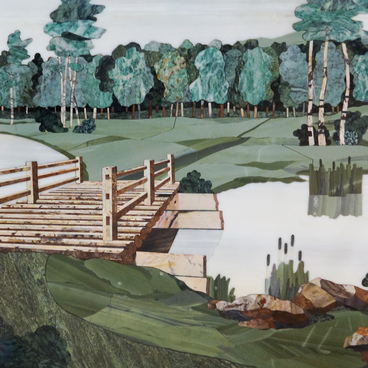This mineralogical hill was created in the 19th century by an unknown master. Such souvenirs have been popular in the Urals since the 18th century. The very first “pyramidal collection of samples” was made in 1786 at the Yekaterinburg Lapidary Factory. The sketch was drawn by artist Bernard Auguste Demally. The hill was a grotto-fountain made of different types and varieties of unprocessed stones. It was accompanied by a schematic map and a list of deposits where the minerals were mined.
The history of Ural mineralogical hills goes back to French applied arts of the 17th century. Furniture makers used decorative hills that were made of pieces of different stones, for finishing expensive cabinets.
In the Urals, production of such souvenirs became one of the main branches of jewelry art. Craftsmen who worked on these products were called “gorochniki” (hill-makers). The basic stages of the work were described by a county statistician Pavel Zverev in his review “Lapidary Craft in the Urals”. According to him, large minerals were broken into smaller pieces with a hammer. Malachite and galena were used to prepare so-called chips: workers crushed minerals into powder, sifted with a strainer, and washed it, so that the powder did not have any impurities, and then dried it.
While the chips were drying, the frame was prepared. Usually wood was used: thanks to it, the entire construction weighed much less. Frame details were fastened with carpenter’s glue and clinked with small nails. There also were stone or metal bases.
The stones were fixed with special putty. It was made of carpenter’s glue, rye flour and soot; river sand and varnish were added to scare off rodents.
The hill was put together from the bottom up. Stones were laid tightly; they were sometimes reshaped so that the gap between them was as small as possible. Seams and gaps were smeared with glue and filled with the chips. A finished hill was drying for several hours near a stove or in the sun. Some stones were covered with varnish to emphasize their shine and protect from gradual corrosion.
The history of Ural mineralogical hills goes back to French applied arts of the 17th century. Furniture makers used decorative hills that were made of pieces of different stones, for finishing expensive cabinets.
In the Urals, production of such souvenirs became one of the main branches of jewelry art. Craftsmen who worked on these products were called “gorochniki” (hill-makers). The basic stages of the work were described by a county statistician Pavel Zverev in his review “Lapidary Craft in the Urals”. According to him, large minerals were broken into smaller pieces with a hammer. Malachite and galena were used to prepare so-called chips: workers crushed minerals into powder, sifted with a strainer, and washed it, so that the powder did not have any impurities, and then dried it.
While the chips were drying, the frame was prepared. Usually wood was used: thanks to it, the entire construction weighed much less. Frame details were fastened with carpenter’s glue and clinked with small nails. There also were stone or metal bases.
The stones were fixed with special putty. It was made of carpenter’s glue, rye flour and soot; river sand and varnish were added to scare off rodents.
The hill was put together from the bottom up. Stones were laid tightly; they were sometimes reshaped so that the gap between them was as small as possible. Seams and gaps were smeared with glue and filled with the chips. A finished hill was drying for several hours near a stove or in the sun. Some stones were covered with varnish to emphasize their shine and protect from gradual corrosion.


